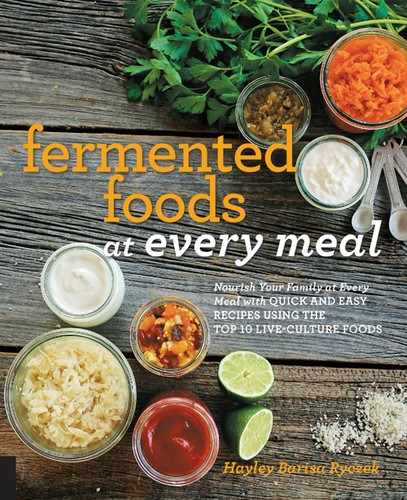Introduction
Whether or not you realize it, fermented foods are part of your everyday life. Fermentation is used in many of the foods you eat regularly, including salami, cheese, yogurt, prosciutto, and bread.
Fermentation has enjoyed a resurgence of interest in recent years, but it’s actually been around for millennia. Every culture in the world has a distinctive history of fermentation, such as kimchi, natto, soy sauce, and fish sauce in Asia; crock-fermented sauerkraut and fermented fish in Northern Europe; and kefir and fermented pickles in the Middle East. Throughout the years, fermentation has been used to help preserve food, keeping it edible long after it was picked or caught fresh. In many ways, fermentation provided the first convenience foods, allowing food to be stored for long periods of time without refrigeration.
But what are fermented foods? Simply put, they are foods that have healthful microbes deliberately added to modify them. Though the bacteria that cause a winter’s outbreak of strep throat are obviously harmful, not all bugs are bad. Bacteria can help keep us healthy in all kinds of ways—from bolstering our immune system to digesting food.
Oftentimes, whether bacteria are good or bad is a matter of balance. For example, candida is naturally occurring bacteria found in our bodies and in small amounts is benign. However, when stress, medications, and poor diet enable it to proliferate, it can seriously damage our intestinal lining and compromise our health in all sorts of ways. When a microbial system is in balance, good microbes keep the bad microbes in line. An overgrowth of bad microbes, however, can take over and disrupt the healthy balance.
Fermentation uses the good bacteria, commonly referred to as probiotics, to make food more nutritious. The fermentation process converts the starches in foods into something that’s more easily digestible. Eating fermented foods introduces the living probiotic cultured microbes into our intestinal tracts and improves digestion, allowing us to absorb more nutrients in the foods we eat. We need these good microbes to keep a healthy balance after eating a diet rich in refined sugar and white flour foods and also to fight illness.
Unfortunately, the American food industry has a phobia when it comes to bacteria. In some ways, that’s a good thing. Sterilization and pasteurization have saved many lives since becoming standard practice in the middle of the twentieth century, but a growing number of people argue that it’s gone too far. The perceived threat of all bacteria in foods, good or bad, has led us to experience an imbalance of bacteria in our guts. This fear of bacteria is unfounded. In fact, historically people have survived because of good bacteria used to ferment foods and keep our digestive tracts healthy and running smoothly. By reintroducing traditional, fermented foods back into our diets, we can help to rebuild healthy gut bacteria.
In this book, I’ll teach you all the reasons why you need to have fermented foods in your diet, how you can easily make 10 fermented foods that you and your family will love, and how to use those foods. Eating something fermented every day is a good starting point. From there, you can build up to integrating fermented foods into every meal. This can be as easy as eating yogurt with breakfast, fermented vegetables with lunch, and a fermented sauce with dinner. You can even squeeze in a refreshing glass of fizzy kombucha between meals! In these pages, you will find 100 recipes that will help you easily add fermented foods to every meal—and even times in between.
In health,

